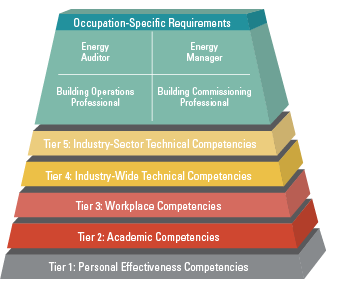Market Challenge
People own, sell, design, build, operate, work in, supply power to, and regulate commercial buildings. Yet, the level of literacy about energy efficiency among these people is surprisingly low. To make a substantial gain in efficiency in the market, it requires a knowledgeable community. Furthermore, the growth of the building energy efficiency field is limited by the availability of a skilled workforce to carry out the work. Employers — including owners, operators, architecture firms, real estate brokerages, service providers — want standardization to have confidence in the quality of employees. Job-seekers want guidance about entry points and career advancement opportunities. Professional associations and training & education providers need to be able to counsel workers and establish training and other programs to support movement into energy-related jobs. And policymakers want to specify levels of competency in their programs.
Changes within the workforce development and education systems have been accelerating as the traditional lines between occupations, particularly in the trades, have changed in the face of a rising demand for energy efficiency workers. Curricula are being modified, the design and engineering enterprise is changing, operations and maintenance functions are becoming more complex, new energy-related educational programming is emerging, unions and associations are trying to keep pace with standards and certifications, and the energy efficiency services sector is gaining a life of its own. However, the market is challenged with much needed standardization and availability of training and education options.
Approach
CBEI recognizes that education and workforce training is foundational to a strong energy efficiency market. In addition to the depth of expertise of the university, private sector, and economic development expertise within the Consortium, CBEI partners with organized labor, workforce investment boards, and certification bodies, to guide workers entering the industry and pursuing additional professional growth within the industry.
CBEI’s approach to developing education and workforce solutions for the market is based on the collective input from the full spectrum of employers and educational institutions focused on this market segment. In addition to looking at the educational gaps, CBEI also identified opportunities to connect underrepresented and displaced workers and veterans with the growing market.
What emerged from CBEI’s early scoping efforts was the need to develop both a structured approach to professional development for workers in the field and a set of targeted training programs that fill some critical gaps. CBEI also partnered with education providers for the K-12 and college students. While early education is critical, CBEI ultimately directed its attention to trade, college, and post-graduate studies.



